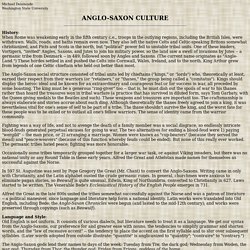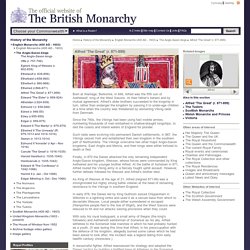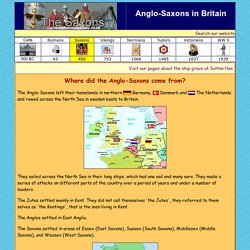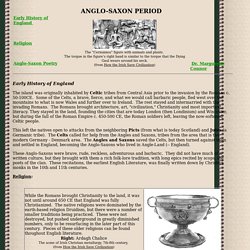

Anglo-Saxon Poetry. Literature: World Literature: British: Old English: Individual Poems: Cynewulf. Anglo-Saxon Culture. Michael Delahoyde Washington State University History: When Rome was weakening early in the fifth century c.e., troops in the outlying regions, including the British Isles, were withdrawn.

Walls, roads, and baths remain even now. They also left the native Celts and Celtic-speaking Britons somewhat christianized, and Picts and Scots in the north, but "political" power fell to unstable tribal units. One of these leaders, Vortigern, "invited" Angles, Saxons, and Jutes to join his military power, so the land saw a swell of invasions by Jutes -- a germanic tribe from Denmark -- in 449, followed soon by Angles and Saxons. (The current name originates as "Angle-Land. ") The Anglo-Saxon social structure consisted of tribal units led by chieftains ("kings," or "lords") who, theoretically at least, earned their respect from their warriors (or "retainers," or "thanes," the group being called a "comitatus").
In 597 St. Language and Style: Old English is not uniform. Works Consulted Mursell, Gordon. Epic World History: Anglo-Saxon Culture. The Anglo-Saxon kings > Alfred 'The Great' Alfred 'The Great' (r. 871-899) Born at Wantage, Berkshire, in 849, Alfred was the fifth son of Aethelwulf, king of the West Saxons.

At their father's behest and by mutual agreement, Alfred's elder brothers succeeded to the kingship in turn, rather than endanger the kingdom by passing it to under-age children at a time when the country was threatened by worsening Viking raids from Denmark. Since the 790s, the Vikings had been using fast mobile armies, numbering thousands of men embarked in shallow-draught longships, to raid the coasts and inland waters of England for plunder. Such raids were evolving into permanent Danish settlements; in 867, the Vikings seized York and established their own kingdom in the southern part of Northumbria. King Alfred the Great. Family tree poster & books House of Wessex Family Tree Detailed Tree Scottish King or Queen at the Time FAQs Name: King Alfred the GreatBorn: c.849 at Wantage, BerkshireParents: Aethelwulf and OsburhRelation to Elizabeth II: 32nd great-grandfatherHouse of: WessexBecame King: 871Married: Ealhswith of MerciaChildren: 5 children, Aelfthryth, Aethelflaed, Aethelgifu, Edward, AethelweardDied: October 26, 899Buried at: WinchesterSucceeded by: his son Edward Anglo-Saxon king 871–899 who defended England against Danish invasion and founded the first English navy.

He succeeded his brother Aethelred to the throne of Wessex in 871, and a new legal code came into force during his reign. He encouraged the translation of scholarly works from Latin (some he translated himself), and promoted the development of the Anglo-Saxon Chronicle. This ensured that his deeds were recorded in history as legends and we know more about him than any other Anglo Saxon King.
Where did the Anglo-Saxons come from? The Anglo-Saxons left their homelands in northern Germany, Denmark and The Netherlands and rowed across the North Sea in wooden boats to Britain.

They sailed across the North Sea in their long ships, which had one sail and many oars. They made a series of attacks on different parts of the country over a period of years and under a number of leaders. The Jutes settled mainly in Kent. The Angles settled in East Anglia. The Saxons settled in areas of Essex (East Saxons), Sussex (South Saxons), Middlesex (Middle Saxons), and Wessex (West Saxons). British Kingdoms (each area ruled by a different king) Anglo Saxons Houses and Saxon villages. We know what Saxons houses may have looked like from excavations of Anglo Saxon villages, such as the one at West Stow in the east of England.

Here, an early Anglo-Saxon village (c.420-650AD) has been carefully reconstructed where it was excavated. Using clues from the what was discovered, archeologists have reconstructed the houses as they may have looked about 1,500 years ago. We know that the Saxons built mainly in wood, although some of their stone churches remain. Anglo-Saxons houses were huts made of wood with roofs thatched with straw.
Much of Britain was covered with forests. There was only one room where everybody ate, cooked, slept and entertained their friends. The houses were built facing the sun to get as much heat and light as possible. Anglo-Saxon Food and Drink. Anglo-Saxons: a brief history. Publication date: 13th January 2011 King Arthur as one of the Nine Worthies, detail from the 'Christian Heroes Tapestry' This period is traditionally known as the Dark Ages, mainly because written sources for the early years of Saxon invasion are scarce.

It is a time of war, of the breaking up of Roman Britannia into several separate kingdoms, of religious conversion and, after the 790s, of continual battles against a new set of invaders: the Vikings. Climate change had an influence on the movement of these new invaders to Britain: in the centuries after 400 AD Europe's average temperature was 1°C warmer than we have today, and in Britain grapes could be grown as far north as Tyneside. Warmer summers meant better crops and a rise in population in the countries of northern Europe. At the same time melting polar ice caused more flooding in low areas, particularly in what is now Denmark, Holland and Belgium. Anglo-saxon. Early History of England The island was originally inhabited by Celtic tribes from Central Asia prior to the invasion by the Romans c. 50-100CE.
